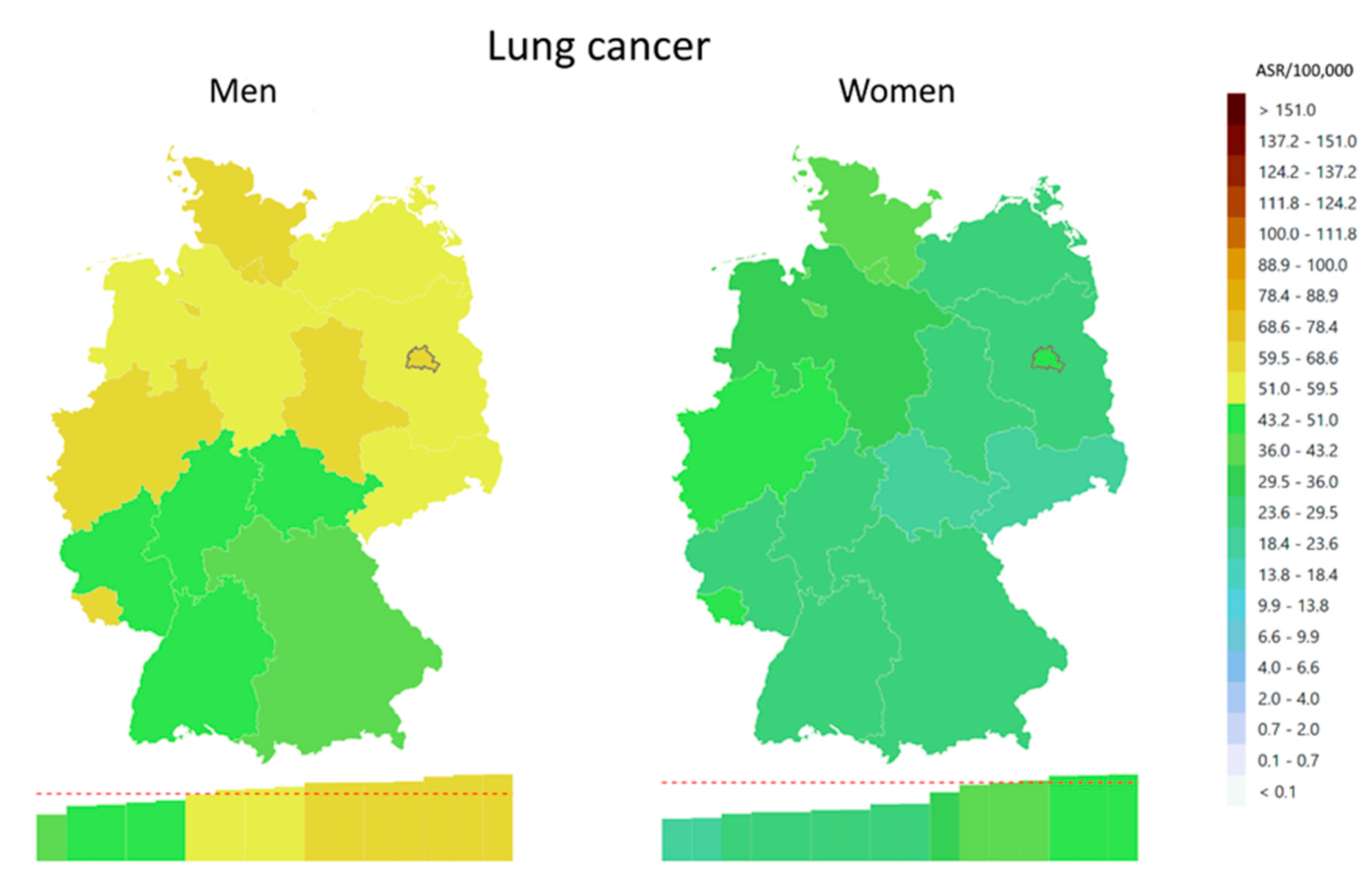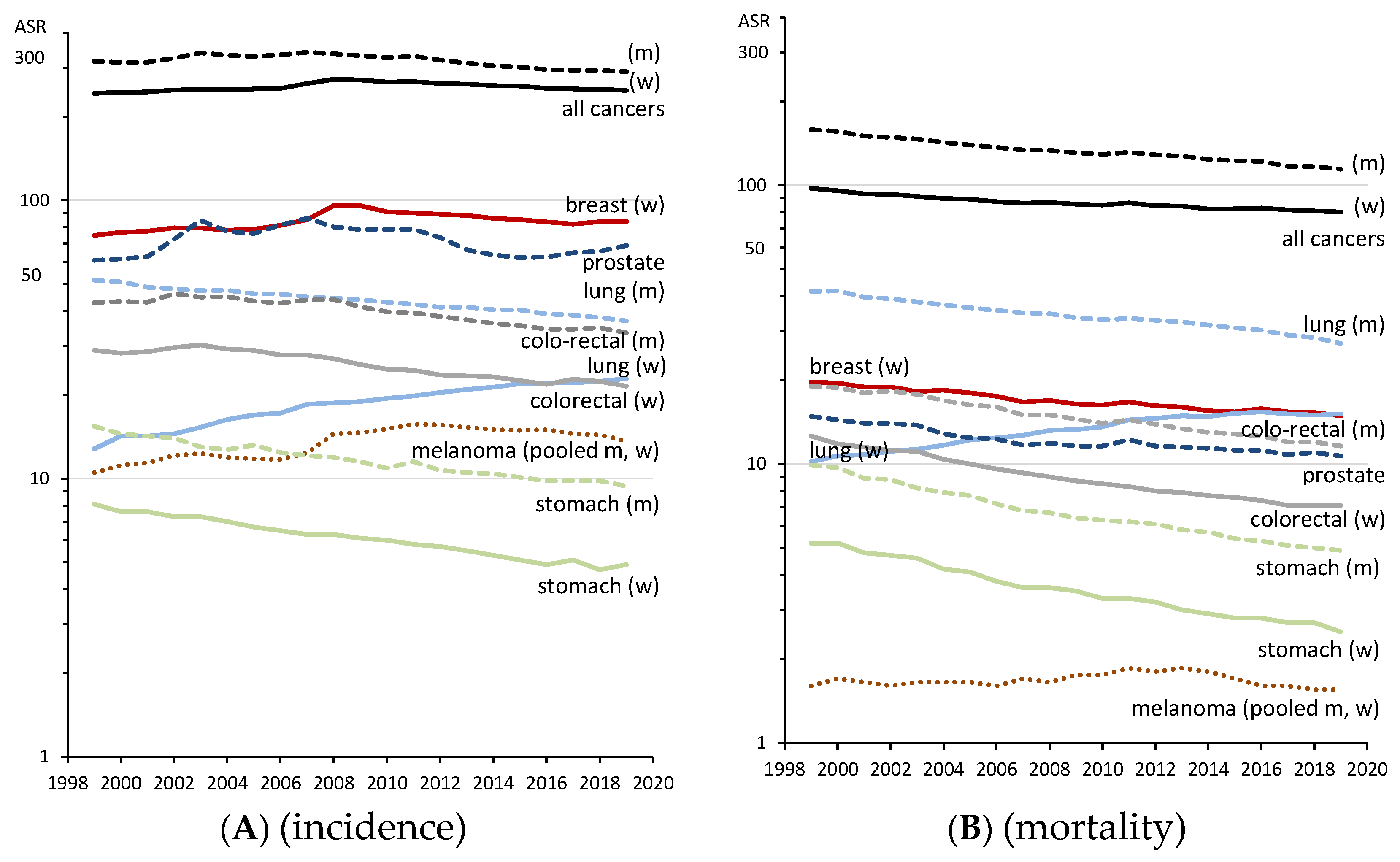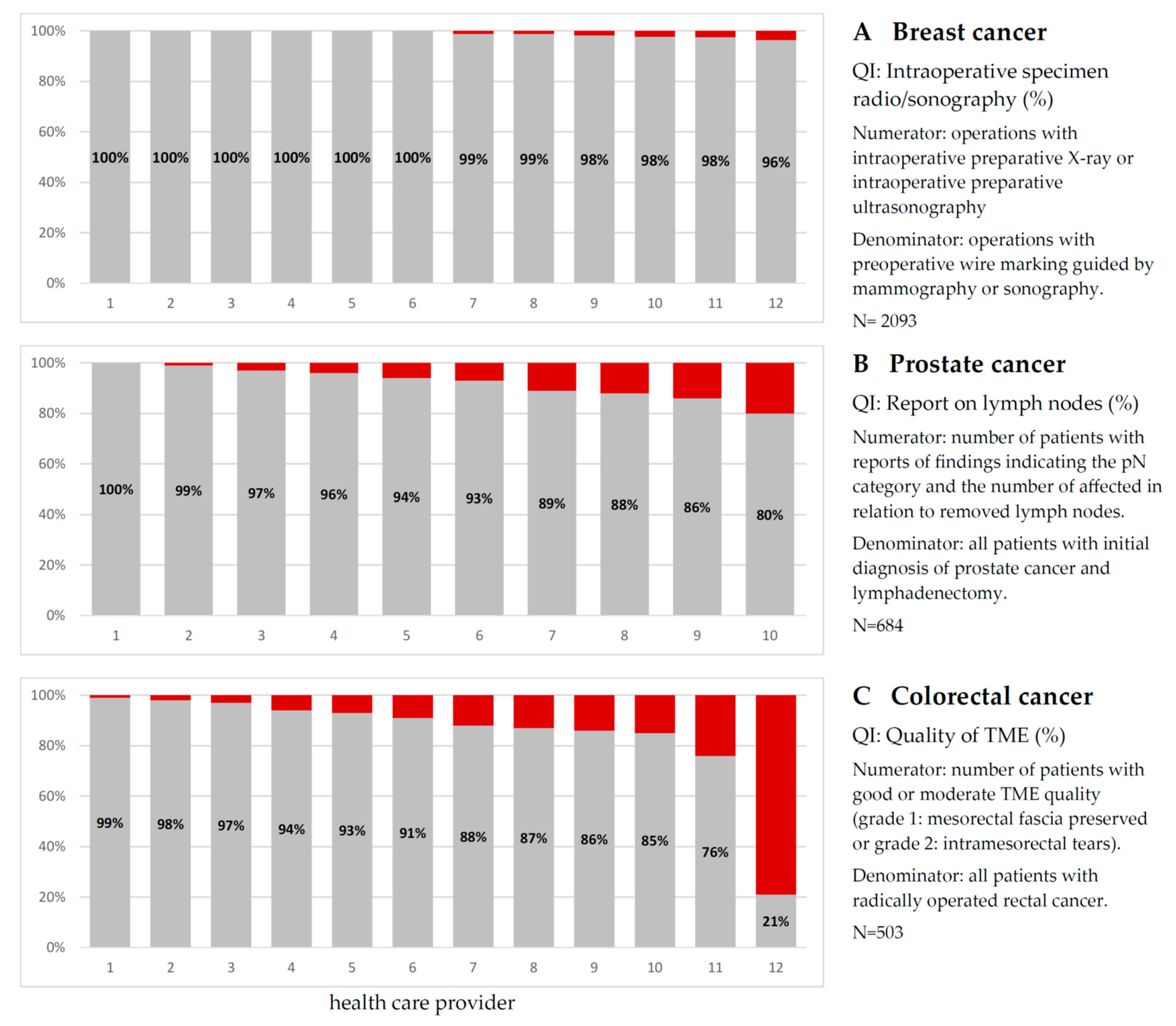Population-Based Clinical Cancer Registration in Germany
Abstract
:Simple Summary
Abstract
1. Introduction
2. Materials and Methods
2.1. Aims and Tasks of the New Clinical Cancer Registration
- -
- Evaluation of the collected clinical data and the feedback of the evaluation results to the individual healthcare providers;
- -
- The promotion of interdisciplinary, directly patient-related cooperation in cancer treatment;
- -
- Participation in the Joint Federal Committee’s inter-institutional and inter-sectoral quality assurance;
- -
- Cooperation with centres in oncology;
- -
- The provision of necessary data for the creation of transparency in care and for the purposes of healthcare research.
2.2. Structure of Cancer Registration
2.3. Notification of Cancer and Data Processing
2.4. Funding of Cancer Registration
2.5. Data and Analyses
3. Results
4. Discussion
5. Conclusions
Supplementary Materials
Author Contributions
Funding
Institutional Review Board Statement
Informed Consent Statement
Data Availability Statement
Conflicts of Interest
References
- Leyden, E.; Kirchner, M.; Wutzdorf, E.; Hansemann, D.; Meyer, G. (Eds.) Report on the Collection Research Surveyed by the Committee on Cancer Research on October 15, 1900; Gustav Fischer: Jena, Germany, 1902. [Google Scholar]
- Cancer Registry Law (Gesetz Über Krebsregister (KRG) 04.11.1994. Available online: http://www.bgbl.de/xaver/bgbl/start.xav?startbk=Bundesanzeiger_BGBl&jumpTo=bgbl194s3351.pdf (accessed on 5 June 2023).
- Hundsdörfer, G. Epidemiological cancer registries in Germany: History from a legal point of view. Bundesgesundheitsblatt Gesundheitsforschung Gesundheitsschutz 2014, 57, 7–12. [Google Scholar] [CrossRef] [PubMed]
- Holleczek, B.; Katalinic, A. Toward a Comprehensive Cancer Registration in Germany. Eur. J. Cancer Prev. 2017, 26, S132–S138. [Google Scholar] [CrossRef] [PubMed]
- Jensen, O.; Parkin, D.; MacLennan, R.; Muir, C.; Skeet, R. Cancer Registration: Principles and Methods; IARC Scientific Publications; IARC: Lyon, France, 1991.
- Klinkhammer-Schalke, M.; Gerken, M.; Barlag, H.; Tillack, A. Quality management in oncology supported by clinical cancer registries. Z. Evid. Fortbild. Qual. Gesundhwes 2015, 109, 452–458. [Google Scholar] [CrossRef] [PubMed]
- European Commission General Data Protection Regulation (GDPR). Available online: https://commission.europa.eu/law/law-topic/data-protection/data-protection-eu_en (accessed on 20 July 2023).
- Spix, C.; Erdmann, F.; Grabow, D.; Ronckers, C. Childhood and Adolescent Cancer in Germany—An Overview. J. Health Monit. 2023, 8, 79–94. [Google Scholar] [PubMed]
- Database Query Tool of the German Centre for Cancer Registry Data at the Robert Koch-Institute. Berlin, Germany. Available online: https://www.krebsdaten.de/Krebs/EN/Database/databasequery_step1_node.html (accessed on 5 June 2023).
- Waterhouse, J.; Muir, C.; Correa, P.; Powell, J. Cancer Incidence in Five Continents Vol. III; IARC: Lyon, France, 1976.
- Holleczek, B.; Gondos, A.; Brenner, H. PeriodR-an R Package to Calculate Long-Term Cancer Survival Estimates Using Period Analysis. Methods Inf. Med. 2009, 48, 123–128. [Google Scholar] [CrossRef] [PubMed]
- Cancer Atlas of the Association of Population-Based Cancer Registries in Germany (GEKID). Available online: https://www.gekid.de/gekid-atlas/ (accessed on 5 June 2023).
- Federal Statistical Office Database of the Federal Statistical Office of Germany-Mortality by Age, Sex, Year and ICD-10. Available online: https://www-genesis.destatis.de/genesis/online (accessed on 5 June 2023).
- Guideline Program Oncology: Guideline-Based Oncological Quality Indicators, V5.0; Leitlinienprogramm Onkologie: Berlin, Germany, 2021.
- Plattform65 Operationalization of S3 Cancer Guideline Indicators. Available online: https://confluence.basisdatensatz.de/pages/viewpage.action?pageId=2818461 (accessed on 5 June 2023).
- Cancer Registry Schleswig-Holstein-Interactive Therapy-Related Report. Available online: https://www.krebsregister-sh.de/iBOB (accessed on 5 June 2023).
- National Cancer Institute Surveillance, Epidemiology, and End Results Program (SEER). Available online: https://seer.cancer.gov/about/ (accessed on 5 June 2023).
- Robert Koch-Institut und die Gesellschaft der epidemiologischen Krebsregister in Deutschland e.V. (Ed.) Cancer in Germany; Robert Koch Institute: Berlin, Germany, 2021; ISBN 978-3-89606-309-0. [Google Scholar]
- Association of the Nordic Cancer Registries. Cancer Registry of Norway NORDCAN: Cancer Incidence, Mortality, Prevalence and Survival in the Nordic Countries, Version 9.2 (23.06.2022). Available online: https://nordcan.iarc.fr/ (accessed on 5 June 2023).
- Netherlands Cancer Registry (NCR) NCR Data. Available online: https://nkr-cijfers.iknl.nl (accessed on 5 June 2023).
- European Commission ECIS-European Cancer Information System. Available online: https://ecis.jrc.ec.europa.eu (accessed on 5 June 2023).
- Pritzkuleit, R.; Eisemann, N.; Katalinic, A. The cartographic depiction of regional variation in morbidity: Data analysis options using the example of the small-scale cancer atlas for Schleswig-Holstein. Bundesgesundheitsblatt Gesundheitsforschung Gesundheitsschutz 2017, 60, 1319–1327. [Google Scholar] [CrossRef] [PubMed]
- Cancer Registry Hamburg Interactive Therapy-Based Cancer Report 2021-Comparioson of Health Care Providers. Available online: https://ijbbehandlungsort.krebsregister-hamburg.de/ (accessed on 5 June 2023).
- OnkoZert Certification System for the Verification of Organ Cancer Centres and Oncology Centres. Available online: https://www.onkozert.de/en/ (accessed on 5 June 2023).
- Giusti, F.; Martos, C.; Trama, A.; Bettio, M.; Sanvisens, A.; Audisio, R.; Arndt, V.; Francisci, S.; Dochez, C.; Ribes, J.; et al. Cancer Treatment Data Available in European Cancer Registries: Where Are We and Where Are We Going? Front. Oncol. 2023, 13, 1109978. [Google Scholar] [CrossRef] [PubMed]
- Siesling, S.; Louwman, W.J.; Kwast, A.; van den Hurk, C.; O’Callaghan, M.; Rosso, S.; Zanetti, R.; Storm, H.; Comber, H.; Steliarova-Foucher, E.; et al. Uses of Cancer Registries for Public Health and Clinical Research in Europe: Results of the European Network of Cancer Registries Survey among 161 Population-Based Cancer Registries during 2010–2012. Eur. J. Cancer 2015, 51, 1039–1049. [Google Scholar] [CrossRef] [PubMed]
- Van Dam, P.A.; Tomatis, M.; Marotti, L.; Heil, J.; Mansel, R.E.; Rosselli Del Turco, M.; van Dam, P.J.; Casella, D.; Bassani, L.G.; Danei, M.; et al. Time Trends (2006–2015) of Quality Indicators in EUSOMA-Certified Breast Centres. Eur. J. Cancer 2017, 85, 15–22. [Google Scholar] [CrossRef] [PubMed]
- Lawson, K.A.; Saarela, O.; Abouassaly, R.; Kim, S.P.; Breau, R.H.; Finelli, A. The Impact of Quality Variations on Patients Undergoing Surgery for Renal Cell Carcinoma: A National Cancer Database Study. Eur. Urol. 2017, 72, 379–386. [Google Scholar] [CrossRef] [PubMed]
- Algera, M.D.; Slangen, B.F.M.; van Driel, W.J.; Wouters, M.W.J.M.; Kruitwagen, R.F.P.M. Textbook Outcome as a Composite Outcome Measure to Compare Hospital Performances Regarding Cytoreductive Surgery for Ovarian Cancer: A Nationwide Population-Based Study. Gynecol. Oncol. 2023, 174, 89–97. [Google Scholar] [CrossRef] [PubMed]
- Algera, M.D.; Baldewpersad Tewarie, N.M.S.; van Driel, W.J.; van Ham, M.A.P.C.; Slangen, B.F.M.; Kruitwagen, R.F.P.M.; Wouters, M.W.J.M. Case-Mix Adjustment to Compare Hospital Performances Regarding Complications after Cytoreductive Surgery for Ovarian Cancer: A Nationwide Population-Based Study. Int. J. Gynecol. Cancer 2023, 33, 534–542. [Google Scholar] [CrossRef]
- Vos, E.L.; Lingsma, H.F.; Jager, A.; Schreuder, K.; Spronk, P.; Vrancken Peeters, M.-J.T.F.D.; Siesling, S.; Koppert, L.B. Effect of Case-Mix and Random Variation on Breast Cancer Care Quality Indicators and Their Rankability. Value Health 2020, 23, 1191–1199. [Google Scholar] [CrossRef]
- Ten Berge, M.G.; Beck, N.; Steup, W.H.; Verhagen, A.F.T.M.; van Brakel, T.J.; Schreurs, W.H.; Wouters, M.W.J.M. Textbook Outcome as a Composite Outcome Measure in Non-Small-Cell Lung Cancer Surgery. Eur. J. Cardio-Thorac. Surg. 2021, 59, 92–99. [Google Scholar] [CrossRef] [PubMed]
- Warps, A.K.; Detering, R.; Tollenaar, R.A.E.M.; Tanis, P.J.; Dekker, J.W.T. Textbook Outcome after Rectal Cancer Surgery as a Composite Measure for Quality of Care: A Population-Based Study. Eur. J. Surg. Oncol. 2021, 47, 2821–2829. [Google Scholar] [CrossRef] [PubMed]
- Zanetti, R.; Sacchetto, L.; Calvia, M.; Bordoni, A.; Hakulinen, T.; Znaor, A.; Møller, H.; Siesling, S.; Comber, H.; Katalinic, A.; et al. Economic Evaluation of Cancer Registration in Europe. J. Regist. Manag. 2014, 41, 31–37. [Google Scholar]
- German Social Code (SGB) Fifth Book (V)-Statutory Health Insurance-§ 65c Clinical Cancer Registries. Available online: https://www.gesetze-im-internet.de/sgb_5/__65c.html (accessed on 5 June 2023).
- Cancer Registry Data Consolidation Act (Gesetz Zur Zusammenführung von Krebsregisterdaten). Available online: https://www.buzer.de/gesetz/14935/index.htm (accessed on 5 June 2023).



| Population (Mio) | Founded | Clinical Data Since | |
|---|---|---|---|
| CR Baden-Wurttemberg | 11.1 | 1994 | 2009 |
| CR Bavaria | 13.1 | 1998 | 2017 |
| CR Berlin and Brandenburg | 6.0 (3.7/2.3) | 1953 | 1953 |
| CR Bremen | 0.7 | 1998 | 2015 |
| Hamburg CR | 1.9 | 1927 | 2014 |
| CR Hesse | 6.3 | 2001 | 2015 |
| CR Lower Saxony | 8.0 | 2000 | 2018 |
| CR Mecklenburg-Western Pomerania | 1.6 | 1953 | 1953 |
| CR North Rhine-Westphalia | 17.9 | ** 1986 | 2016 |
| CR Rhineland-Palatinate | 4.1 | 1997 | 2016 |
| Saarland CR | 1.0 | 1968 | 2016 |
| CR Saxony | 4.1 | 1953 | 1953 |
| CR Saxony-Anhalt | 2.2 | 2018 | 1993 |
| CR Schleswig-Holstein | 2.9 | 1997 | 2017 |
| CR Thuringia | 2.1 | 1953 | 1953 |
| German Childhood Cancer Registry | 13.5 | 1980 | - |
| German centre of cancer registry data at the Robert Koch-Institute * | (84.0) | 1983 | 2023 |
| Item Class | Collected Information |
|---|---|
| Basic dataset | ~130 item |
| Personal data patient | Health insurance numbers, names, address, date of birth and gender |
| Personal data notifying institution | Names, address, billing data |
| Cancer diagnosis | ICD-10, ICD-O topography, date, certainty, side |
| Histology | Date, ICD-O morphology, grading, lymph nodes examined and involved, if pathology report: name and address of physician sending in the sample |
| Tumour classification | TNM and other |
| Genetic variants | Type |
| Residual state | After surgery and total assessment |
| Performance status | ECOG (at diagnosis) |
| Surgery | Date, intention, OPS codes, complication |
| Radiotherapy | Date, intention, position to surgery, target area, begin, end, dose, boost, complication (CTCAE) |
| Systemic therapy | Date, intention, position to surgery, kind of therapy (including active surveillance), protocol, drug, begin, end |
| Tumour conference | Date, type |
| Follow-up | Date, total assessment of tumour, lymph nodes, metastases |
| Death | Date, cause |
| Organ specific modules | Specific items for quality assurance |
| Breast cancer module | 10 items |
| Prostate cancer module | 10 items |
| Colorectal cancer module | 12 items |
| Melanoma of the skin module | 4 items |
| Women | Men | |||||||||
|---|---|---|---|---|---|---|---|---|---|---|
| Cancer Site | N | CR | ASR | % (Place) | 5Y-RS% | N | CR | ASR | Place-S | 5Y-RS% |
| Oral cavity, pharynx (C00–C14) | 4357 | 10.4 | 4.6 | 1.8 (15) | 61.3 | 9521 | 23.2 | 11.5 | 3.5 (9) | 50.5 |
| Oesophagus (C15) | 1627 | 3.9 | 1.5 | 0.7 (19) | 26.3 | 5694 | 13.9 | 6.3 | 2.1 (12) | 26.4 |
| Stomach (C16) | 5650 | 13.4 | 4.8 | 2.4 (10) | 39.1 | 9091 | 22.2 | 9.4 | 3.4 (10) | 35.0 |
| Colo-rectal (C18–C20) | 26,655 | 63.3 | 22.1 | 11.3 (2) | 68.2 | 33,440 | 81.6 | 34.3 | 12.4 (3) | 64.8 |
| Pancreas (C25) | 9546 | 22.7 | 7.3 | 4.0 (7) | 13.6 | 9614 | 23.4 | 9.6 | 3.6 (7) | 12.4 |
| Lung (C34) | 22,892 | 54.4 | 22.5 | 9.7 (3) | 25.0 | 34,572 | 84.3 | 36.0 | 12.8 (2) | 20.6 |
| Melanoma (C43) | 11,038 | 26.2 | 14.1 | 4.7 (5) | 95.3 | 12,527 | 30.6 | 14.4 | 4.7 (5) | 94.0 |
| Breast (C50) | 73,279 | 174.1 | 86.2 | 31.0 (1) | 86.5 | 721 | 1.8 | 0.8 | 0.3 (18) | 78.8 |
| Cervix uteri (C53) | 4517 | 10.7 | 7.2 | 1.9 (14) | 61.6 | - | - | - | - | - |
| Corpus uteri (C54–C55) | 11,221 | 26.7 | 11.6 | 4.8 (4) | 78.4 | - | - | - | - | - |
| Ovary (C56) | 7128 | 16.9 | 7.6 | 3.0 (9) | 41.3 | - | - | - | - | - |
| Prostate (C61) | - | - | - | - | - | 70,192 | 171.2 | 70.0 | 26.1 (1) | 90.3 |
| Testis (C62) | - | - | - | - | - | 4113 | 10.0 | 9.3 | 1.5 (14) | 92.4 |
| Kidney (C64) | 4912 | 11.7 | 4.6 | 2.1 (12) | 79.2 | 9505 | 23.2 | 10.9 | 3.5 (8) | 78.2 |
| Bladder (C67) | 4697 | 11.2 | 3.5 | 2.0 (13) | 70.4 | 13,116 | 32.0 | 12.2 | 4.9 (4) | 78.5 |
| Brain (C70–C72) | 3002 | 7.1 | 4.0 | 1.3 (18) | 27.9 | 3909 | 9.5 | 5.5 | 1.5 (13) | 24,3 |
| Thyroid gland (C73) | 4113 | 9.8 | 7.3 | 1.7 (16) | 92.0 | 1816 | 4.4 | 3.0 | 0.7 (16) | 86.3 |
| Hodgkin lymphoma (C81) | 1063 | 2.5 | 2.3 | 0.5 (20) | 89.1 | 1386 | 3.4 | 2.7 | 0.5 (17) | 86.0 |
| Non-Hodgkin lym. (C82–C88) | 8094 | 19.2 | 7.7 | 3.4 (8) | 73.3 | 10,042 | 24.5 | 11.3 | 3.7 (6) | 71.1 |
| Multiple myeloma (C90) | 3073 | 7.3 | 2.5 | 1.3 (17) | 59.3 | 3835 | 9.4 | 3.9 | 1.4 (15) | 57.8 |
| Leukaemia (C91–C95) | 5263 | 12.5 | 5.2 | 2.2 (11) | 59.0 | 7467 | 18.2 | 8.5 | 2.8 (11) | 60.7 |
| All sites excluding C44 | 236,218 | 561.2 | 249.0 | 100.0 | 67.0 | 269,394 | 657.0 | 290.3 | 100.0 | 63.4 |
| Patients Total N = 1734 | UICC Stages I–II N = 554 | UICC Stages III–IV N = 792 | UICC Stage Unknown N = 388 | |
|---|---|---|---|---|
| Surgery | 1200 (69%) | 432 (78%) | 591 (75%) | 177 (46%) |
| Curative intention | 1003 (84%) | 372 (86%) | 465 (79%) | 166 (94%) |
| Resection R0 * | 1047 (91%) | 394 (95%) | 496 (87%) | 157 (92%) |
| Operation within 14 days after diagnosis | 285 (24%) | 128 (30%) | 145 (25%) | 12 (7%) |
| Radiation | 850 (33%) | 92 (17%) | 286 (36%) | 202 (52%) |
| Curative intention | 552 (95%) | 90 (98%) | 268 (94%) | 194 (96%) |
| Premature termination | 25 (4%) | 5 (5%) | 11 (4%) | 9 (4%) |
| Neoadjuvant | 452 (78%) | 67 (73%) | 215 (75%) | 170 (84%) |
| Chemotherapy | 698 (40%) | 87 (16%) | 428 (54%) | 183 (47%) |
| Curative intention | 458 (69%) | 68 (72%) | 280 (69%) | 110 (65%) |
| Premature termination | 152 (22%) | 10 (11%) | 1127 (26%) | 30 (16%) |
| Neoadjuvant | 310 (44%) | 41 (47%) | 175 (41%) | 94 (51%) |
| Immune/Antibody-therapy | 99 (14%) | 2 (2%) | 79 (18%) | 18 (10%) |
| cytostatic agents used: | ||||
| Antimetabolic | 672 (96%) | 85 (98%) | 410 (96%) | 177 (97%) |
| Platin-based | 333 (48%) | 29 (33%) | 217 (51%) | 110 (60%) |
| Topoisomerase inhibitors | 115 (16%) | 2 (2%) | 90 (21%) | 23 (13%) |
Disclaimer/Publisher’s Note: The statements, opinions and data contained in all publications are solely those of the individual author(s) and contributor(s) and not of MDPI and/or the editor(s). MDPI and/or the editor(s) disclaim responsibility for any injury to people or property resulting from any ideas, methods, instructions or products referred to in the content. |
© 2023 by the authors. Licensee MDPI, Basel, Switzerland. This article is an open access article distributed under the terms and conditions of the Creative Commons Attribution (CC BY) license (https://creativecommons.org/licenses/by/4.0/).
Share and Cite
Katalinic, A.; Halber, M.; Meyer, M.; Pflüger, M.; Eberle, A.; Nennecke, A.; Kim-Wanner, S.-Z.; Hartz, T.; Weitmann, K.; Stang, A.; et al. Population-Based Clinical Cancer Registration in Germany. Cancers 2023, 15, 3934. https://doi.org/10.3390/cancers15153934
Katalinic A, Halber M, Meyer M, Pflüger M, Eberle A, Nennecke A, Kim-Wanner S-Z, Hartz T, Weitmann K, Stang A, et al. Population-Based Clinical Cancer Registration in Germany. Cancers. 2023; 15(15):3934. https://doi.org/10.3390/cancers15153934
Chicago/Turabian StyleKatalinic, Alexander, Marco Halber, Martin Meyer, Maren Pflüger, Andrea Eberle, Alice Nennecke, Soo-Zin Kim-Wanner, Tobias Hartz, Kerstin Weitmann, Andreas Stang, and et al. 2023. "Population-Based Clinical Cancer Registration in Germany" Cancers 15, no. 15: 3934. https://doi.org/10.3390/cancers15153934
APA StyleKatalinic, A., Halber, M., Meyer, M., Pflüger, M., Eberle, A., Nennecke, A., Kim-Wanner, S.-Z., Hartz, T., Weitmann, K., Stang, A., Justenhoven, C., Holleczek, B., Piontek, D., Wittenberg, I., Heßmer, A., Kraywinkel, K., Spix, C., & Pritzkuleit, R. (2023). Population-Based Clinical Cancer Registration in Germany. Cancers, 15(15), 3934. https://doi.org/10.3390/cancers15153934






